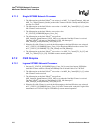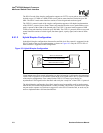
292 Hardware Reference Manual
Intel
®
IXP2800 Network Processor
Media and Switch Fabric Interface
8.8.5 From DRAM to TBUF for Instruction:
dram[tbuf_wr, --, src_op1, src_op2, ref_cnt], indirect_ref
For the transfers from DRAM, the TBUF acts like a slave. The address of the data to be written is
given in D_PUSH_ID. The data is registered and assembled from D_PUSH_BUS, and then written
into TBUF.
8.9 Receiver and Transmitter Interoperation with Framers and
Switch Fabrics
The Intel
®
IXP2800 Network Processor can process data received at a peak rate of 16 Gb/s and
transmit data at a peak rate of 16 Gb/s. In addition, data may be received and transmitted via the
PCI bus at an aggregate peak rate of 4.2 Gb/s, as shown in Figure 101.
The network processor’s receiver and transmitter can be independently configured to support either
an SPI-4.2 framer interface or a fabric interface consisting of DDR LVDS signaling and the CSIX-
L1 protocol. The dynamic training sequence of SPI-4.2, used for de-skewing the signals, has been
optionally incorporated into the fabric interface.
“SPI-4.2 is an interface for packet and cell transfer between a physical layer (PHY) device and a
link layer device, for aggregate bandwidths of OC-192 ATM and Packet over SONET/SDH (POS),
as well as 10 Gb/s Ethernet applications.”
1
“CSIX-L1 is the Common Switch Interface. It defines a physical interface for transferring
information between a traffic manager (Network Processor) and a switching fabric…”
2
The
network processor adopts the protocol of CSIX-L1, but uses a DDR LVDS physical interface rather
than an LVCMOS or HSTL physical interface.
Figure 101. Basic I/O Capability of the Intel
®
IXP2800 Network Processor
B2734-01
Intel
®
IXP2800
Network
Processor
PCI
4.2 Gb/s
Peak
Transmitter
Receiver
16 Gb/s Peak 16 Gb/s Peak
1. “System Packet Interface Level 4 (SPI-4) Phase 2: OC-192 System Interface for Physical and Link Layer Devices,” Implementation
Agreement: OIF-SPI4-02.0, Optical Internetworking Forum
2. “CSIX-L1: Common Switch Interface Specification-L1,” CSIX


















